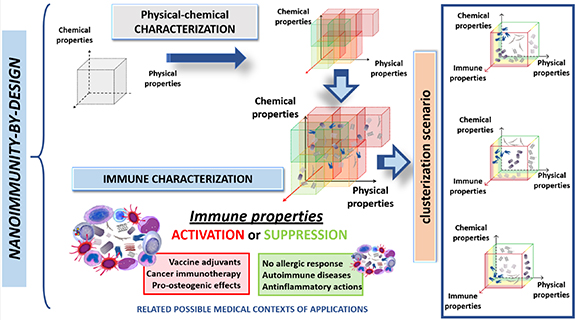Carbon-based materials (CBMs), such as graphene, nanodiamonds, carbon fibers, and carbon dots, have attracted much scientific attention as promising biomedical tools. Following exposure, particularly intravenous injection, these nanomaterials can be recognized by immune cells. Such interactions could be modulated by the different physicochemical properties of the materials (eg, structure, size, and chemical functions), by either stimulating or suppressing the immune response. However, a harmonized cutting-edge approach for the classification of these materials based not only on their physicochemical parameters but also their immune properties was missing. The European Commission-funded G-IMMUNOMICS and CARBO-IMmap projects aimed to fill this gap, developing a functional pipeline for the qualitative and quantitative immune characterization of graphene, graphene-related materials (GRMs), and other CBMs. The goal was to open breakthrough perspectives for the definition of the immune profiles of these materials. Here, we summarize our methodological approach, key results, and the necessary multidisciplinary expertise ranging across various fields, from material chemistry to engineering, immunology, toxicology, and systems biology. G-IMMUNOMICS, as a partnering project of the Graphene Flagship, the largest scientific research initiative on graphene worldwide, also complemented the studies performed in the Flagship on health and environmental impact of GRMs. Finally, we present the nanoimmunity-by-design concept, developed within the projects, which can be readily applied to other 2D materials. Overall, the G-IMMUNOMICS and CARBO-IMmap projects have provided new insights on the immune impact of GRMs and CBMs, thus laying the foundation for their safe use and future translation in medicine.

Carbon-based materials (CBMs), such as graphene, nanodiamonds, carbon fibers, and carbon dots, have attracted much scientific attention as promising biomedical tools. Following exposure, particularly intravenous injection, these nanomaterials can be recognized by immune cells. Such interactions could be modulated by the different physicochemical properties of the materials (eg, structure, size, and chemical functions), by either stimulating or suppressing the immune response. However, a harmonized cutting-edge approach for the classification of these materials based not only on their physicochemical parameters but also their immune properties was missing. The European Commission-funded G-IMMUNOMICS and CARBO-IMmap projects aimed to fill this gap, developing a functional pipeline for the qualitative and quantitative immune characterization of graphene, graphene-related materials (GRMs), and other CBMs. The goal was to open breakthrough perspectives for the definition of the immune profiles of these materials. Here, we summarize our methodological approach, key results, and the necessary multidisciplinary expertise ranging across various fields, from material chemistry to engineering, immunology, toxicology, and systems biology. G-IMMUNOMICS, as a partnering project of the Graphene Flagship, the largest scientific research initiative on graphene worldwide, also complemented the studies performed in the Flagship on health and environmental impact of GRMs. Finally, we present the nanoimmunity-by-design concept, developed within the projects, which can be readily applied to other 2D materials. Overall, the G-IMMUNOMICS and CARBO-IMmap projects have provided new insights on the immune impact of GRMs and CBMs, thus laying the foundation for their safe use and future translation in medicine.
